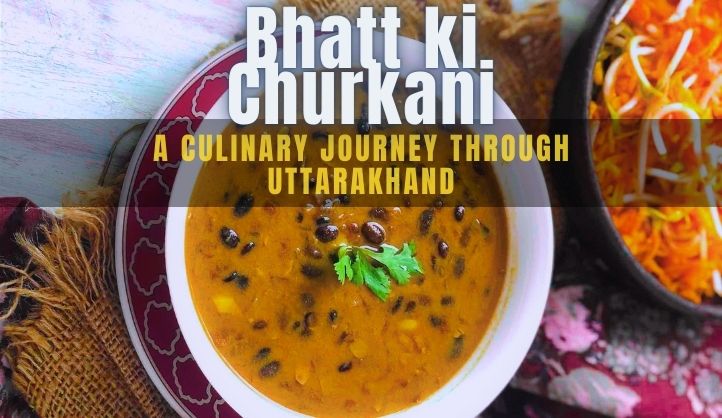Nestled in the heart of Northern India lies a culinary gem that is not only rich in flavor but also steeped in tradition. Bhatt ki Churkani, a delectable dish originating from the Garhwal region of Uttarakhand, is a testament to the region’s vibrant culinary heritage. With its aromatic spices and hearty ingredients, Bhatt ki Churkani has gained popularity not only among locals but also among food enthusiasts worldwide. Let’s delve into the essence of this dish and uncover its fascinating story.
The Origin of Bhatt ki Churkani
Bhatt ki Churkani traces its roots back to the Garhwal region, where it has been a staple dish for generations. The term “Bhatt” refers to black soybeans, which are the star ingredient of this dish. Soybeans have long been cultivated in the region for their nutritional value and versatility in cooking. The Churkani refers to the method of preparation, which involves slow-cooking the soybeans with a medley of spices and vegetables.
Ingredients and Preparation
The beauty of Bhatt ki Churkani lies in its simplicity and use of locally sourced ingredients. The key components include black soybeans, potatoes, onions, tomatoes, garlic, ginger, and a blend of spices such as cumin, coriander, turmeric, and red chili powder.
To prepare Bhatt ki Churkani, the black soybeans are soaked overnight to soften them, making them easier to cook. The next day, the soybeans are boiled until tender, while the potatoes are diced and sautéed with onions, garlic, and ginger until golden brown. The boiled soybeans are then added to the mixture along with diced tomatoes and a generous sprinkle of spices. The dish is slow-cooked until the flavors meld together, resulting in a thick and aromatic gravy.
Flavors and Variations
Bhatt ki Churkani tantalizes the taste buds with its robust flavors and comforting texture. The earthiness of the soybeans is complemented by the warmth of the spices, creating a harmonious balance of sweet, savory, and spicy notes. The addition of potatoes adds a creamy texture to the dish, while the onions and tomatoes impart a subtle sweetness.
While the traditional recipe remains cherished, there are various regional variations of Bhatt ki Churkani that reflect the diverse culinary landscape of Northern India. Some variations include the addition of leafy greens such as spinach or fenugreek, while others may incorporate local herbs and spices for added depth of flavor.
Cultural Significance
Beyond its culinary appeal, Bhatt ki Churkani holds cultural significance in the Garhwal region, where it is often served during festive occasions and family gatherings. It is a dish that brings people together, evoking a sense of warmth and hospitality that is characteristic of Northern Indian culture.
Moreover, Bhatt ki Churkani embodies the ethos of sustainability and self-sufficiency, as it relies on locally sourced ingredients that are readily available in the region. Its preparation is a labor of love, passed down through generations as a cherished family recipe.
Other traditional dishes of Uttarakhand
Uttarakhand, known for its stunning landscapes and rich cultural heritage, boasts a diverse culinary tradition influenced by its geography, climate, and cultural practices. Here are some other local and traditional dishes of Uttarakhand:
- Kafuli: Kafuli is a popular dish made with spinach or fenugreek leaves cooked in a yogurt-based gravy. It is seasoned with garlic, ginger, and a blend of spices, imparting a unique flavor to the dish. Kafuli is often served with steamed rice or roti and is cherished for its hearty and nutritious qualities.
- Bhang Ki Chutney: Bhang Ki Chutney is a tangy and spicy condiment made from hemp seeds. The seeds are ground into a paste and mixed with ingredients like lemon juice, green chilies, and coriander leaves to create a flavorful chutney. It is typically served as an accompaniment to traditional Uttarakhandi meals.
- Aloo Ke Gutke: Aloo Ke Gutke is a simple yet flavorful dish made with boiled potatoes sautéed with mustard seeds, cumin seeds, and aromatic spices like turmeric and red chili powder. It is often served as a side dish or snack and pairs well with roti or rice.
- Bal Mithai: Bal Mithai is a traditional sweet treat originating from the Kumaon region of Uttarakhand. It is made by simmering khoya (reduced milk) until thick and creamy, then shaping it into bite-sized balls and coating them with sugar. Bal Mithai has a rich, fudgy texture and is typically enjoyed during festivals and special occasions.
- Ras Bhaat: Ras Bhaat is a comforting dish made with rice cooked in a spiced yogurt gravy. The yogurt is seasoned with spices like cumin, mustard seeds, and asafoetida, giving the dish a tangy and aromatic flavor. Ras Bhaat is often served hot and is a popular choice for lunch or dinner.
- Chainsoo: Chainsoo is a traditional dal (lentil) dish native to Uttarakhand, particularly the Garhwal region. It is made with black gram lentils (urad dal) cooked with spices like cumin, coriander, and ginger. Chainsoo has a thick and creamy consistency and is typically served with rice or roti.
- Singodi: Singodi is a traditional sweet made with khoya (reduced milk) and grated coconut. The mixture is wrapped in leaves of the Malu tree and allowed to set, imparting a subtle earthy flavor to the sweet. Singodi is popularly enjoyed as a dessert during festivals and celebrations.
These dishes represent just a glimpse of the rich and diverse culinary heritage of Uttarakhand, each reflecting the region’s unique flavors, ingredients, and cultural influences. Exploring these traditional dishes offers a delightful journey into the heart of Uttarakhand’s gastronomic traditions.
Conclusion
In conclusion, Bhatt ki Churkani is more than just a dish; it is a culinary masterpiece that celebrates the rich tapestry of flavors and traditions of Northern India. From its humble origins in the Garhwal region to its widespread popularity today, Bhatt ki Churkani exemplifies the essence of Indian cuisine – simple yet flavorful, comforting yet exotic.
So, the next time you crave a taste of authentic Northern Indian cuisine, why not embark on a culinary adventure and savor the flavors of Bhatt ki Churkani? It’s a journey worth taking, one spoonful at a time.
FAQs about Bhatt ki Churkani
What are black soybeans, and where can I find them?
Black soybeans are a variety of soybeans known for their rich flavor and nutritional benefits. They can typically be found in specialty grocery stores, health food stores, or online retailers specializing in Indian or Asian ingredients.
Is Bhatt ki Churkani a vegan-friendly dish?
Yes, Bhatt ki Churkani is inherently vegan, as it consists primarily of plant-based ingredients such as black soybeans, potatoes, vegetables, and spices. It’s a perfect option for those following a vegan diet or looking to incorporate more plant-based meals into their routine.
Can I adjust the spice level of Bhatt ki Churkani to suit my taste?
Absolutely! The beauty of homemade dishes like Bhatt ki Churkani lies in their adaptability. You can easily adjust the amount of spices according to your preference. If you prefer a milder flavor, reduce the amount of red chili powder or omit it altogether. Conversely, if you enjoy a spicier kick, feel free to increase the quantity of chili powder or add fresh green chilies to the dish.
Are there any variations of Bhatt ki Churkani that I should try?
While the traditional recipe for Bhatt ki Churkani is cherished for its simplicity and authenticity, there are indeed several variations worth exploring. Some cooks may add leafy greens such as spinach or fenugreek for added nutritional value, while others may experiment with different combinations of spices or vegetables to create unique flavor profiles. Exploring these variations can add an exciting twist to this classic dish.
Can I prepare Bhatt ki Churkani in advance and store it for later consumption?
Yes, Bhatt ki Churkani lends itself well to advance preparation and can be stored for later consumption. Once cooked, allow the dish to cool to room temperature before transferring it to an airtight container. It can be stored in the refrigerator for up to 3-4 days or frozen for longer-term storage. Simply reheat the dish gently on the stovetop or in the microwave before serving, adding a splash of water if needed to maintain the desired consistency.





